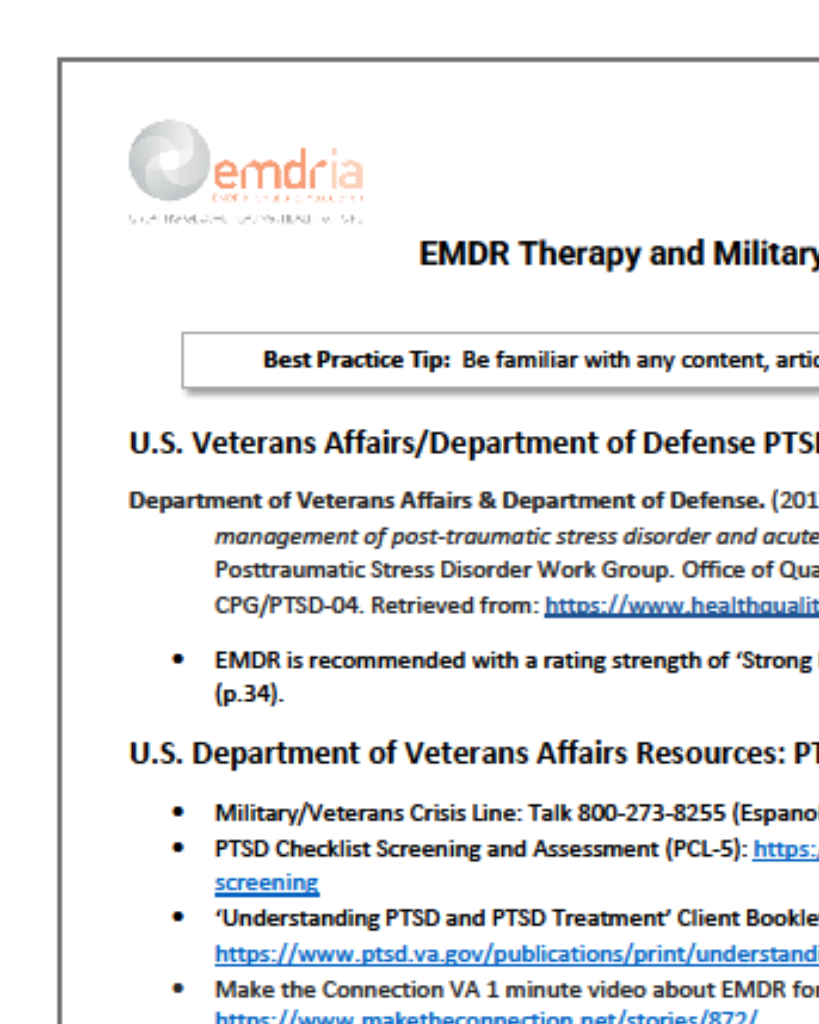Eye-movement desensitization and reprocessing (EMDR) in the 21st century
This chapter gives an overview of EMDR therapy discussing that EMDR treats the whole person – their cognitions, their emotions, their body, and their stored traumatic memories.
About the Chapter
“In 35 years, eye movement desensitization and reprocessing (EMDR) therapy has evolved from Francine Shapiro’s chance personal discovery to becoming one of the leading psychotherapy treatments for post-traumatic stress disorder (PTSD) worldwide. EMDR treats the whole person – their cognitions, their emotions, their body, and their stored traumatic memories. Grounded in Shapiro’s adaptive information processing (AIP) model, EMDR proposes that traumatic memories are incorrectly stored and need to be reprocessed for symptoms to resolve and learning to occur. The EMDR therapist activates the patient’s innate self-healing process. It also uses dual attention awareness, one foot in the present and one foot in the past, in the form of bilateral stimulation of the brain to help keep patients in the window of tolerance. New research shows that overloading working memory while reprocessing traumatic memory could lead to even greater speed, efficiency, and cost savings. While EMDR is currently recommended by the World Health Organization and the Institute of Traumatic Stress Studies for the treatment of PTSD, the new ICD-11 diagnosis of complex post-traumatic stress (C-PTSD), which includes “disorders of the self,” presents new clinical challenges. Continued research needs to be conducted in the form of randomized control trials (RCTs) in PTSD treatment while also developing new protocols and techniques for C-PTSD.”
—Description from publisher
Chapter Access
Purchase/Subscription Required
Niskanen, N. (2024). Eye-movement desensitization and reprocessing (EMDR) in the 21st century. In E. Senreich, S. L. Ashenberg Straussner, & J. Dann (Eds.), Experiential therapies for treatment trauma. Routledge. https://doi.org/10.4324/9781003455851
eBook ISBN: 9781003455851
About the Book
“Experiential Therapies for Treating Trauma offers 17 chapters, with 15 of them focusing on a different experiential psychotherapy for treating trauma, written by clinicians with expertise in that modality. No other book contains descriptions of such a wide array of experiential therapies under one cover. Readers will obtain both a comprehensive overview of the many experiential therapies that are currently utilized and specific knowledge regarding how to utilize each of them in psychotherapy practice. The authors of each chapter emphasize that in working with clients impacted by trauma, there is a need for the use of therapeutic modalities that go beyond the cognitive processes central to talk therapy and incorporate more holistic, sensory approaches that emphasize the building of a strong relationship between the client and therapist. Both experienced clinicians and students will find this book to be an invaluable resource to enhance their knowledge of how to use experiential therapies and to motivate them to obtain advanced training in modalities that spark their interest.”
—Description from publisher
Date
December 15, 2024
Creator(s)
Noora Niskanen
Practice & Methods
AIP, Efficacy
Extent
15 pages
Publisher
Routledge
APA Citation
Niskanen, N. (2024). Eye-movement desensitization and reprocessing (EMDR) in the 21st century. In E. Senreich, S. L. Ashenberg Straussner, & J. Dann (Eds.), Experiential therapies for treatment trauma. Routledge. https://doi.org/10.4324/9781003455851
Audience
EMDR Therapists, Other Mental Health Professionals
Language
English
Content Type
Chapter
Access Type
External Resource





